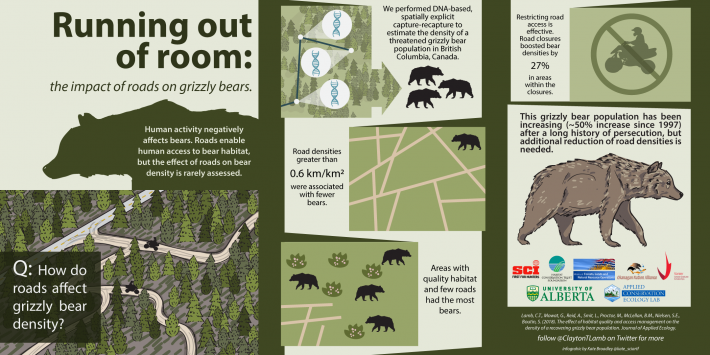The road to recovery: Closing roads counters effects of habitat loss for grizzly bears
University of Alberta press release
It’s simple math, says scientist Clayton Lamb. The closer grizzly bears are to humans, the more ways there are for bears to die. Put more simply, more roads equals fewer grizzly bears.
The study was recently published in Journal of Applied Ecology.

In a recent study, examining a non-invasive DNA (hair collection) dataset of grizzly bear activity in British Columbia, Lamb and his colleagues conclusively determine what scientists have long suspected: higher road density leads to lower grizzly bear density, a critical problem for a species still rebounding from a long period of human persecution.
“The problem with grizzly bears and roads is a North American-wide issue. This is the first study that strongly links roads to decreased grizzly bear density,” said Lamb, currently completing his PhD with University of Alberta conservation biologist Stan Boutin. “Not only do bears die near roads, bears also avoid these areas, making many habitats with roads through them less effective. By closing roads, we can reduce the negative impact of roads in a lot of ways. We can’t turn roads back into forest tomorrow, so the best thing we can do right now is to close them. The effects are immediate.”
“The problem with grizzly bears and roads is a North American-wide issue. This is the first study that strongly links roads to decreased grizzly bear density”
Lamb and his colleagues studied a threatened population of grizzlies in the Monashee Mountains, just east of the Okanagan, the leading edge of bear recovery efforts in British Columbia. Lamb described the population as low but recovering, with a few bears slowly recolonizing the Okanagan where they used to roam but are currently locally extinct, or extirpated.
“Grizzly bears are recovering in a lot of areas, but habitat loss and human-bear conflict remain huge problems that can compromise recovery,” said Lamb.
Following the December, 2017 closure of the grizzly bear hunt in British Columbia, Lamb commented, “It is more important than ever that the public recognize the continuing threats to bear populations. Current road densities in British Columbia represent a problem for bear conservation. We are losing wilderness in the province, and there are fewer grizzly bears where road densities are high. We’re taking it another step further and advising that closing roads will do a lot to improve bear populations.”
Lamb said the findings can be applied to other habitats throughout North America. Along with a new scientific paper, Lamb and his colleagues, conservation scientists with the BC government, produced a land management guide focused on maintaining the spatial integrity of the landscape to bolster grizzly bear density.
The BC-born Lamb–a Vanier scholar–said wildlife conservation is rooted in his veins. “I grew up in the outdoors. I developed an increasing appreciation for wild places and conserving them. I realized that science was an outlet to protect these places and the species that inhabit them.”
Thanks to Lamb’s work, roads closures are already in the works for the Monashee Mountain area.
Read the full article (freely available for a limited time)
The effect of habitat quality and access management on the density of a recovering grizzly bear population, Journal of Applied Ecology. doi: 10.1111/1365-2664.13056
Media contact
Jennifer Pascoe, University of Alberta. Email: jennifer.pascoe@ualberta.ca, telephone: 780.492.8813
Like what we stand for?
Support our mission and help develop the next generation of ecologists by donating to the British Ecological Society.